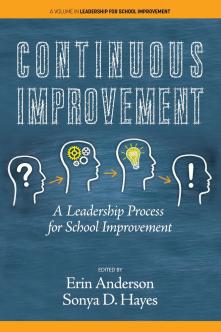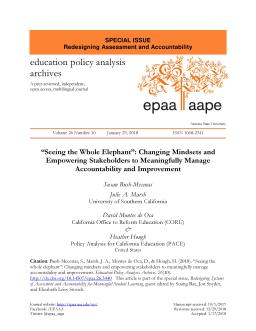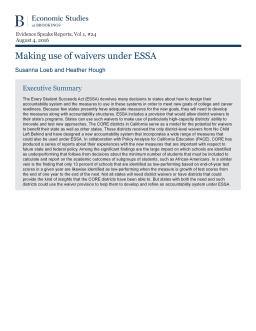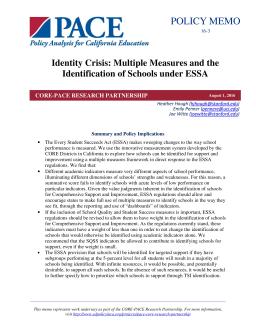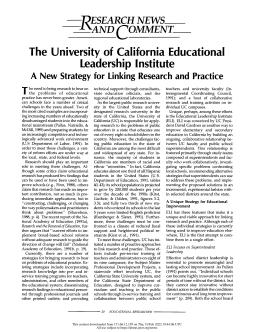Improvement Team Leads’ Perspectives on Fitting Improvement Work to Their Sites
Published
Summary
This chapter in an edited book focuses on the work of two improvement network hubs in California as they tried to support participating districts and schools to improve the proportion of students “on-track” for post-secondary success. California has a particular stake in figuring out how to support districts in consistently using continuous improvement (CI) to achieve measurable gains in student outcomes because state policy (e.g., Local Control Funding Formula, California’s Every Student Succeeds Act Plan) prescribes CI as the approach to improvement in its accountability system.
How School Districts Craft Coherence Towards Continuous Improvement
Published
Summary
This study uses qualitative case study methods to explore how educators establish system-wide continuous improvement capabilities and coherence for implementation, taking into consideration the local contexts. Educators use two bridging approaches to crafting coherence: weaving and stacking. The study contributes to understanding how leaders create shared meaning and practice in complex and dynamic educational systems. The implications for both research and practice are discussed.
Changing Mindsets and Empowering Stakeholders to Meaningfully Manage Accountability and Improvement
Published
Summary
The shift towards multiple-measure dashboard accountability has potential for promoting more meaningful learning, but also comes with challenges. Lessons learned from research on CORE Districts show that a shift to flexibility and capacity building efforts has challenges. Oakland Unified School District's approach suggests that districts have agency to modify mindsets by modeling inquiry, openness, and flexibility, giving stakeholders space and authority to manage accountability and improvement.
Insights From California’s CORE Waiver Districts
Published
Summary
California's Local Control Funding Formula (LCFF) aims to improve educational equity by providing additional funds to districts with disadvantaged students. Districts are required to engage with their communities and develop Local Control Accountability Plans (LCAPs) to identify priorities and allocate funds. However, there are concerns about the quality of LCAPs, lack of stakeholder involvement, and limited transparency. To improve the effectiveness of LCFF, districts must ensure meaningful stakeholder engagement and use data to guide decision-making.
Learning from the CORE Districts' Focus on Measurement, Capacity Building, and Shared Accountability
Published
Summary
California and the US are undergoing a cultural shift in school accountability policies towards locally-determined measures of school performance. Lessons can be learned from the CORE districts, which developed an innovative accountability system, emphasizing support over sanctions, and utilizing multiple measures of school quality. The CORE districts' measurement system and collaboration hold promise for improving local systems, but efforts to build capacity remain a work in progress.
Published
Summary
ESSA allows states to design accountability systems and measures to meet new college and career readiness goals. With the lack of adequate measures, states will need to develop new measures and structures. The CORE Districts in CA, with its innovative accountability system and waivers from No Child Left Behind, is a model for other states. Reports from CORE-PACE highlight the impact of decisions such as subgroup sizes and test score growth on identifying low-performing schools. States can use the district waiver provision to help develop and refine their accountability systems under ESSA.
Multiple measures and the identification of schools under ESSA
Published
Summary
This report examines the Every Student Succeeds Act (ESSA) and how schools can be identified for support and improvement using a multiple measures framework. The authors find that different academic indicators measure different aspects of school performance and suggest that states should be allowed to use multiple measures instead of a summative rating. They also find that non-academic indicators are not given enough weight and suggest a clarification in federal policy.
A New Strategy for Linking Research and Practice
Published
Summary
The US faces critical challenges in education, such as incorporating disadvantaged students and preparing them for a competitive, tech-driven work environment. To meet these challenges, reform efforts are underway. Despite claims that educational research has produced few applicable findings, it has contributed by changing how policymakers and practitioners think about problems. The National Academy of Education argues that implementing broad-based reforms without adequate research will fail. Research must play an important role in meeting these challenges.
Overcoming Barriers, Creating New Opportunities
Published
Summary
This article highlights the changing nature of childhood, with increasing physical and mental health problems, substance abuse, child abuse, inadequate child care, and family disorganization. Furthermore, schools struggle to meet the needs of non-middle-class, nonwhite, non-English-speaking children, as more students from these backgrounds enter public schools. To improve educational prospects, school leaders must recognize how children's daily lives affect their education and adapt to these changes.
